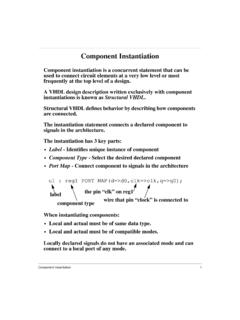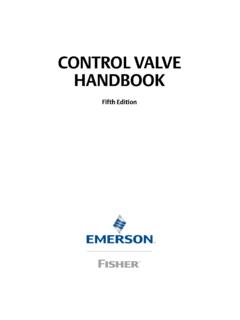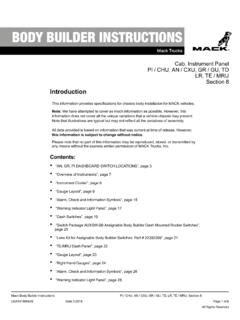Transcription of National Health Statistics Reports
1 National Health Statistics ReportsNumber 122 December 20, DEPARTMENT OF Health AND HUMAN SERVICESC enters for disease control and PreventionNational center for Health StatisticsMean body Weight, Height, Waist Circumference, and body Mass Index Among Adults: United States, 1999 2000 Through 2015 2016 by Cheryl D. Fryar, , Deanna Kruszon-Moran, , Qiuping Gu, , and Cynthia L. Ogden, This report presents trends in mean weight, height, waist circumference, and body mass index (BMI) among adults in the United States from 1999 2000 through 2015 2016. Methods Data were obtained from physical examinations of a nationally representative sample of adults aged 20 and over in the National Health and Nutrition Examination Surveys during 1999 2016. The tables present means and standard errors of the mean for weight (n = 45,047), height (n = 46,481), waist circumference (n = 43,169), and BMI (n = 44,859) separately for men and women overall, by age group, and by race and Hispanic origin for each 2-year survey period.
2 Changes in these body measures over time were evaluated using linear Since 1999, mean weight, waist circumference, and BMI increased for all age groups, for non-Hispanic white and Mexican-American men and women, and for non-Hispanic black women. Among non-Hispanic black men, weight, waist circumference, and BMI increased until 2005 2006 and then remained level. No change in height was seen over time except for a decrease in crude estimates among all women, a decrease among men and women aged 40 59, and an increase in both crude and age-adjusted estimates of mean height for men followed by a decrease after 2003 2004. No significant trends were seen in any of the four body measures for non-Hispanic Asian men and women (data available only for 2011 2016).Conclusions Mean weight, waist circumference, and BMI in adults have increased over the past 18 years.
3 Conversely, mean height did not change in many demographic subgroups and, in some groups, was lower in 2015 2016 than in 1999 : anthropometry BMI National Health and Nutrition Examination Survey (NHANES)IntroductionSince 1980, the prevalence of obesity among adults based on body mass index (BMI) has increased in the United States (1 4). This is in part due to a shift in the distribution of BMI in the entire population (5,6). This report presents updated trends (6) in mean body weight, height, waist circumference, and BMI for the adult population from 1999 2000 through 2015 2016 by sex, age, and race and Hispanic origin. MethodsThe National Health and Nutrition Examination Survey (NHANES) is conducted by the National center for Health Statistics . Household interviews followed by Health examinations, conducted in mobile examination centers (MECs), are used to collect NHANES data.
4 The MECs are staffed by full-time personnel, including Health technicians who conduct body measurements using standardized examination procedures. Surveys were conducted on a periodic basis from 1960 through 1994. Beginning in 1999, NHANES became a continuous survey. The procedures followed to select the sample and conduct the interview and examination were similar to those for Page 2 National Health Statistics Reports Number 122 December 20, 2018previous surveys (7). Public-use data from the continuous NHANES are released in 2-year cycles (8). Sample descriptionNHANES is a complex, multistage probability sample of the civilian noninstitutionalized population. Non-Hispanic black and Mexican- American persons, among other groups, have been oversampled to obtain reliable estimates for these population subgroups.
5 Beginning in 2007, all Hispanic persons were oversampled, and beginning in 2011, non-Hispanic Asian persons were included in the oversample. Data were available for 47,233 examined sample persons aged 20 and over from nine NHANES 2-year cycles from 1999 2016. The overall examination response rates for adults aged 20 and over during 1999 2016 ranged from to Age and race and Hispanic-origin categories used for this report were based on the survey sample domains that were recommended in the NHANES Analytic Guidelines (9). Adult s age was based on age at household screener. Participants with age at screener equal to 19 years but whose age at the MEC exam was 240 months or more (n = 100) were classified as adults aged 20 and over and included in the 47,233 examined sample persons in this report. Pregnant women (n = 1,428) were excluded from all analyses, except for height.
6 Additionally, body measurement data were missing for weight (n = 758), height (n = 752), weight or height for BMI (n = 946), and waist circumference (n = 2,636). Missing data for each outcome was set to missing for a final sample size of 45,047 for body weight; 46,481 for height; 43,169 for waist circumference; and 44,859 for BMI. Technical Notes Tables I IV show the unweighted sample size for each body measure by survey years, age group, and race and Hispanic origin separately for men and women aged 20 and over. Age was categorized into three groups: 20 39, 40 59, and 60 and over. Race and Hispanic-origin groups included those reporting as non-Hispanic white, non-Hispanic black, non-Hispanic Asian, all Hispanic, and Mexican American. Adults who reported another race (including multiple races) were included in total estimates but were not reported measurements The anthropometry component methodology has remained consistent over time.
7 Weight has been measured to the nearest kilogram using a digital weight scale. Waist circumference measurements have been made to the nearest centimeter using a tape measure at the uppermost lateral border of the hip crest (ilium) (10). Standing height has been measured with a wall-mounted digital stadiometer. Weight and standing height values were recorded automatically. Waist circumference measurement data were recorded using computer-assisted data entry, and all results were based on a single body measurement at examination. The NHANES Anthropometry Procedures Manual describes the protocol, equipment, quality control , and measurement procedures in detail (11). BMI was calculated as weight in kilograms divided by height in meters squared (kg/m2).Statistical analysisNHANES examination sample weights were applied to adjust for oversampling of certain populations, noncoverage, and nonresponse (from screener to interview and from interview to examination) in order to calculate National estimates of the mean.
8 Standard errors of the mean were estimated using sample weights and the Taylor Series Linearization method (12) in SUDAAN to incorporate the complex sample design. A relative standard error (RSE) greater than 30% is used to define estimates that are considered not statistically reliable. All of the RSEs for estimates in this report met the reliability criterion. All results are presented stratified by sex. Stratified estimates for men and women are presented overall and by age group, and age adjusted overall and by race and Hispanic origin subgroup to the 2000 projected Census population using the direct method and age groups 20 39, 40 59, and 60 and over. Estimates were not available until 2007 2008 for total Hispanic persons and 2011 2012 for non-Hispanic Asian persons. Therefore, tables show results from 2007 2008 through 2015 2016 for total Hispanic persons and from 2011 2012 through 2015 2016 for non-Hispanic Asian persons.
9 Results were calculated for measurements in both English (inches [in] and pounds [lb]) and metric (centimeters [cm] and kilograms [kg]) units. Statistical tests on both linear-only and linear-plus quadratic trends were modeled using SUDAAN PROC REGRESS. Overall trend tests were conducted on both crude and age-adjusted population totals. Significance was determined using the Satterthwaite adjusted F test (13) at the level. Joinpoint software (using the modified Bayesian information criterion test and specifying a minimum of three data points per segment) was used to determine the change point in the trend line for those outcomes where the quadratic term was significant. Piecewise linear regression using SUDAAN PROC REGRESS was used to test the significance of the slope for each line segment and the significance of the difference between slopes for the two line segments.
10 ResultsWeightEstimates of mean body weight for adult men and women aged 20 and over from 1999 2000 through 2015 2016 are presented in Tables 1 and 2. A significant linear increase in body weight was seen over time for both men and women and for each race and Hispanic-origin and age subgroup, except for non-Hispanic black men, non-Hispanic Asian men and women (measured using data from 2011 2012 through 2015 2016 only), and Mexican-American women. Among all men, mean age-adjusted body weight was kg ( lb) in 2015 2016, up from kg ( lb) in 1999 2000. Among all women, mean age-adjusted body weight was kg ( lb) in 2015 2016, up from kg ( lb) in 1999 2000. No National Health Statistics Reports Number 122 December 20, 2018 Page 3significant trend was seen in body weight for non-Hispanic Asian men or women.















